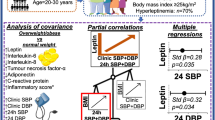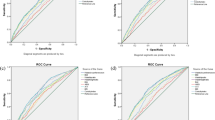Abstract
Hypertension is highly prevalent in South Africa, resulting in high stroke mortality rates. Since obesity is very common among South African women, it is likely that obesity contributes to the hypertension prevalence. The aims were to determine whether black African women have higher blood pressures (BPs) than Caucasian women, and whether obesity is related to their cardiovascular risk. African (N=102) and Caucasian (N=115) women, matched for age and body mass index, were included. Correlations between obesity (total body fat, abdominal obesity and peripheral fat) and cardiovascular risk markers (haemodynamic parameters, lipids, inflammatory markers, prothrombotic factors, adipokines, HOMA-IR (homoeostasis model assessment insulin resistance)) were compared between the ethnic groups (adjusted for age, smoking, alcohol and physical activity). Comparisons between low- and high-BP groups were also made for each ethnic group. Results showed that African women had higher BP (P<0.01) with increased peripheral vascular resistance. Surprisingly, African women showed significantly weaker correlations between obesity measures and cardiovascular risk markers when compared to Caucasian women (specifically systolic BP, arterial resistance, cardiac output, fibrinogen, plasminogen activator inhibitor-1, leptin and resistin). Interestingly, the latter risk markers were also not significantly different between low- and high-BP African groups. African women, however, presented significant correlations of obesity with triglycerides, C-reactive protein and HOMA that were comparable to the Caucasian women. Although urban African women have higher BP than Caucasians, their obesity levels are weakly related to traditional cardiovascular risk factors compared to Caucasian women. The results, however, suggest a link with the development of insulin resistance.
This is a preview of subscription content, access via your institution
Access options
Subscribe to this journal
Receive 12 digital issues and online access to articles
$119.00 per year
only $9.92 per issue
Buy this article
- Purchase on Springer Link
- Instant access to full article PDF
Prices may be subject to local taxes which are calculated during checkout



Similar content being viewed by others
References
Opie LH, Seedat YK . Hypertension in sub-Saharan African populations. Circulation 2005; 112: 3562–3568.
Steyn K, Kazenellenbogen JM, Lombard CJ, Bourne LT . Urbanization and the risk for chronic diseases of lifestyle in the black population of the Cape Peninsula, South Africa. J Cardiovasc Risk 1997; 4: 135–142.
Schutte AE, van Rooyen JM, Huisman HW, Kruger HS, de Ridder JH . Factor analysis of possible risks for hypertension in a black South African population. J Hum Hypertens 2003; 17: 339–348.
Hoosen S, Seedat YK, Bhigjee AI, Neerahoo RM . A study of urinary sodium and potassium excretion rates among urban and rural Zulus and Indians. J Hypertens 1985; 3: 351–358.
Worthington MG, Wendt MC, Opie LH . Sodium transport in hypertension: assessment of membrane-associated defects in South African black and white hypertensives. J Hum Hypertens 1993; 7: 291–297.
Joubert J, Norman R, Bradshaw D, Goedecke JH, Steyn NP, Puoane T . Estimating the burden of disease attributable to excess body weight in South Africa in 2000. S Afr Med J 2007; 97: 683–690.
van der Merwe MT, Pepper MS . Obesity in South Africa. Obes Rev 2006; 7: 315–322.
Puoane T, Steyn K, Bradshaw D, Laubscher R, Fourie J, Lambert V et al. Obesity in South Africa: the South African demographic and health survey. Obes Res 2002; 10: 1038–1048.
Walker AR, Adam F, Walker BF . World pandemic of obesity: the situation in Southern African populations. Public Health 2001; 115: 368–372.
Bateman C . Black women at major risk for obesity-related diseases. S Afr Med J 2007; 97: 490.
Colin BA, Adair LS, Popkin BM . Ethnic differences in the association between body mass index and hypertension. Am J Epidemiol 2002; 155: 346–353.
Sakurai M, Miura K, Takamura T, Ota T, Ishizaki M, Morikawa Y et al. Gender differences in the association between anthropometric indices of obesity and blood pressure in Japanese. Hypertens Res 2006; 29: 75–80.
Schutte AE, Kruger HS, Wissing MP, Underhay C, Vorster HH . The emergence of the metabolic syndrome in urban obese African women: The POWIRS-Study. S Afr J Sci 2005; 101: 61–67.
World Health Organization. Obesity: Preventing and Managing the Global Epidemic. Report of a WHO Consultation on Obesity, June 3–5. World Health Organization: Geneva, 1997.
Schutte AE, Huisman HW, Schutte R, Malan L, van Rooyen JM, Malan NT et al. Differences and similarities regarding adiponectin investigated in African and Caucasian women. Eur J Endocrinol 2007; 157: 181–188.
Norton K, Olds T . Anthropometrica. A Textbook of Body Measurement for Sports and Health Courses. University of New South Wales Press: Sydney, 1996.
Ginde SR, Geliebter A, Rubiano F, Silva AM, Wang J, Heshka S et al. Air displacement plethysmography: validation in overweight and obese subjects. Obes Res 2005; 13: 1232–1237.
Fields DA, Higgins PB, Radley D . Air-displacement plethysmography: here to stay. Curr Opin Clin Nutr Metab Care 2005; 8: 624–629.
Imholz BPM, Wieling W, van Montfrans GA, Wesseling KH . Fifteen years experience with finger arterial pressure monitoring: assessment of the technology. Cardiovasc Res 1998; 38: 605–616.
Clauss A . [Rapid physiological coagulation method in determination of fibrinogen]. Acta Haematol 1957; 17: 237–246.
Meiring M, Badenhorst PN, Kelderman M . Performance and utility of a cost-effective collagen-binding assay for the laboratory diagnosis of Von Willebrand disease. Clin Chem Lab Med 2007; 45: 1068–1072.
Okosun IS, Boltri JM, Anochie LK, Chandra KM . Racial/ethnic differences in prehypertension in American adults: population and relative attributable risks of abdominal obesity. J Hum Hypertens 2004; 18: 849–855.
Tiago AD, Badenhorst D, Nkeh B, Candy GP, Brooksbank R, Sareli P et al. Impact of renin–angiotensin–aldosterone system gene variants on the severity of hypertension in patients with newly diagnosed hypertension. Am J Hypertens 2003; 16: 1006–1010.
Olckers A, Towers GW, van der MA, Schwarz PE, Rheeder P, Schutte AE . Protective effect against type 2 diabetes mellitus identified within the ACDC gene in a black South African diabetic cohort. Metabolism 2007; 56: 587–592.
Oelofse A, Jooste PL, Steyn K, Badenhorst CJ, Lombard C, Bourne L et al. The lipid and lipoprotein profile of the urban black South Africa population of the Cape Peninsula—the BRISK study. S Afr Med J 1996; 86: 162–166.
Walker AR, Walker BF, Manetsi B, Tsotetsi NG, Walker AJ . Obesity in black women in Soweto, South Africa: minimal effects on hypertension, hyperlipidaemia and hyperglycaemia. J R Soc Health 1990; 110: 101–103.
Steyn K, Sliwa K, Hawken S, Commerford P, Onen C, Damasceno A et al. Risk factors associated with myocardial infarction in Africa: the INTERHEART Africa study. Circulation 2005; 112: 3554–3561.
Vorster HH . Fibrinogen and women's health. Thromb Res 1999; 95: 137–154.
Vorster HH, Jerling JC, Steyn K, Badenhorst CJ, Slazus W, Venter CS et al. Plasma fibrinogen of black South Africans: the BRISK study. Public Health Nutr 1998; 1: 169–176.
Longo-Mbenza B, Tonduangu K, Muyeno K, Phanzu M, Kebolo BA, Muvova D et al. Predictors of stroke—associated mortality in Africans. Rev Epidemiol Sante Publique 2000; 48: 31–39.
The IDF consensus worldwide definition of the metabolic syndrome. International Diabetes Federation; www.idf.org, 2005.
Ludvigsson J . Why diabetes incidence increases—a unifying theory. Ann NY Acad Sci 2006; 1079: 374–382.
Das UN . Is obesity an inflammatory condition? Nutrition 2001; 17: 953–966.
Yudkin JS . Inflammation, obesity, and the metabolic syndrome. Horm Metab Res 2007; 39: 707–709.
Acknowledgements
We thank the participants, supporting staff and collaborators, Drs A Olckers and GW Towers from the Centre for Genome Research of the NWU, for their involvement in this project. We also thank the following funding bodies: the South African National Research Foundation (GUN 2054068), the Medical Research Council, the South African Sugar Association, the Centre for Genome Research of the NWU, DNAbiotec (Pty) Ltd, the Dresden University of Technology funding grant MeDDrive, the Commission of the European Communities, Grant Agreement no. 2004310 and the Africa Unit for Transdisciplinary Health Research (AUTHeR) of the North-West University (Potchefstroom campus).
Author information
Authors and Affiliations
Corresponding author
Rights and permissions
About this article
Cite this article
Schutte, A., Huisman, H., Van Rooyen, J. et al. Should obesity be blamed for the high prevalence rates of hypertension in black South African women?. J Hum Hypertens 22, 528–536 (2008). https://doi.org/10.1038/jhh.2008.35
Received:
Revised:
Accepted:
Published:
Issue Date:
DOI: https://doi.org/10.1038/jhh.2008.35
Keywords
This article is cited by
-
Is BMI a Useful Indicator of Prenatal Health Among Black American Women?
Journal of Racial and Ethnic Health Disparities (2023)
-
Recent advances in understanding hypertension development in sub-Saharan Africa
Journal of Human Hypertension (2017)
-
Determining cut-off values for neck circumference as a measure of the metabolic syndrome amongst a South African cohort: the SABPA study
Endocrine (2012)
-
Ethnic‐specific Correlations of Visfatin With Circulating Markers of Endothelial Inflammation and Function
Obesity (2009)



